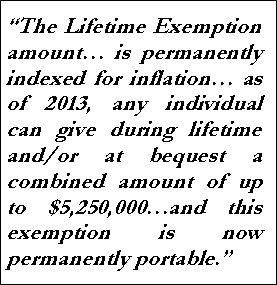The start of a new year often inspires reflections on the past, with renewed effort to apply any lessons we've learned to try to anticipate

Carry On
It may already seem like a distant memory, but the last few months of 2012 were quite tumultuous as a result of the uncertainty surrounding the so-called fiscal cliff. Despite some significant unfinished business that got deferred to 2013—specifically the sequester and how to handle it—there were still many deliberate actions taken at the end of December worth celebrating. Of course, all sorts of compromises affecting the taxation of income and capital gains were made in the Taxpayer Relief Act of 2012, but one area that received fairly widespread improvement was estate and gift tax legislation. Moreover, these decisions were made permanent. While nothing is ever completely permanent when Congress is in session, the New Year’s Day tax law ended a decade of uncertainty and provided greater reliability in overall estate planning.
This recent legislation also reaffirmed the on-again, off-again “unified system” affecting gifts and bequests, which had been scheduled to expire if we had gone over the proverbial (fiscal) cliff. The law permanently and retroactively set the Lifetime Exemption amount (for total gifts and/or bequests) at $5 million – the same level as a few years ago. Additionally, this exemption (sometimes called the unified credit) is permanently indexed for inflation—which means that as of 2013, any individual can now give during lifetime and/or at bequest a combined amount of up to $5,250,000 free of estate or gift tax. Even more, this exemption amount is now permanently portable. The concept of “portability” was introduced a few years ago, but only temporarily. It allows a surviving spouse to automatically inherit and utilize any unused lifetime gifting exemption amount that the deceased spouse did not use—as long as an estate tax return is filed. This is different from the unlimited marital deduction that still remains and permits unlimited transfers between spouses. With portability, a couple can now essentially exempt up to $10.5 million without any complicated legal maneuvers. This has implications on estate planning and could affect the use of bypass or credit shelter trusts.
Prior to portability, bypass trusts were commonly used to take full advantage of an individual’s available exemption amount. Any amount not given away or bequeathed but still covered by the exemption (or corresponding “credit”) could go into a trust for the surviving spouse’s benefit. Importantly, this meant that assets in these trusts were deliberately designed to stay out of the surviving spouse’s estate. This not only took advantage of the credit but also meant that any future growth and capital appreciation would also stay out of the surviving spouse’s estate… and this objective may still be worthwhile instead of just relying on portability. Also, unlike the exemption amount itself, there is no inflation adjustment for the portable amount, which could be another reason to apply the exemption sooner with a bypass trust. And yet, bypass trusts do not get a step up in cost basis at the second death, and this could be an undesirable trade off. Also, bypass trusts typically get less favorable income tax treatment on lower thresholds of income that are not distributed to beneficiaries.
Portability, however, does not apply to the exemption from generation-skipping transfer (GST) tax—so these types of (multi-generational) transfers still need proactive planning. Indeed, for many families, GST trusts still offer maximum leverage of the Lifetime Exemption, because they can be used to effectively establish “Dynasty Trusts” that can last in perpetuity and without estate taxation. The current Administration, though, is considering new requirements, such as the payment of estate tax at least every 90 years (and currently this tax rate is 40%). However, if enacted, any new provisions would likely only apply to trusts created after enactment. So for the very wealthy—who can afford to pass wealth beyond both the spouse and the next generation—it might make sense to consider a Dynasty Trust now. Of course, there are many other valid reasons for using bypass trusts that go beyond strictly tax related reasons alone, such as divorce and asset protection, handling a second marriage, asset management, and spendthrift provisions. But these are mainly unrelated to utilizing the credit itself. In addition, there are still separate reasons to use various kinds of (living) trusts for other objectives, such as guarding privacy, avoiding probate, and simplifying estate settlement.
Articles and Commentary
Information provided in written articles are for informational purposes only and should not be considered investment advice. There is a risk of loss from investments in securities, including the risk of loss of principal. The information contained herein reflects Sand Hill Global Advisors' (“SHGA”) views as of the date of publication. Such views are subject to change at any time without notice due to changes in market or economic conditions and may not necessarily come to pass. SHGA does not provide tax or legal advice. To the extent that any material herein concerns tax or legal matters, such information is not intended to be solely relied upon nor used for the purpose of making tax and/or legal decisions without first seeking independent advice from a tax and/or legal professional. SHGA has obtained the information provided herein from various third party sources believed to be reliable but such information is not guaranteed. Certain links in this site connect to other websites maintained by third parties over whom SHGA has no control. SHGA makes no representations as to the accuracy or any other aspect of information contained in other Web Sites. Any forward looking statements or forecasts are based on assumptions and actual results are expected to vary from any such statements or forecasts. No reliance should be placed on any such statements or forecasts when making any investment decision. SHGA is not responsible for the consequences of any decisions or actions taken as a result of information provided in this presentation and does not warrant or guarantee the accuracy or completeness of this information. No part of this material may be (i) copied, photocopied, or duplicated in any form, by any means, or (ii) redistributed without the prior written consent of SHGA.
Video Presentations
All video presentations discuss certain investment products and/or securities and are being provided for informational purposes only, and should not be considered, and is not, investment, financial planning, tax or legal advice; nor is it a recommendation to buy or sell any securities. Investing in securities involves varying degrees of risk, and there can be no assurance that any specific investment will be profitable or suitable for a particular client’s financial situation or risk tolerance. Past performance is not a guarantee of future returns. Individual performance results will vary. The opinions expressed in the video reflect Sand Hill Global Advisor’s (“SHGA”) or Brenda Vingiello’s (as applicable) views as of the date of the video. Such views are subject to change at any point without notice. Any comments, opinions, or recommendations made by any host or other guest not affiliated with SHGA in this video do not necessarily reflect the views of SHGA, and non-SHGA persons appearing in this video do not fall under the supervisory purview of SHGA. You should not treat any opinion expressed by SHGA or Ms. Vingiello as a specific inducement to make a particular investment or follow a particular strategy, but only as an expression of general opinion. Nothing presented herein is or is intended to constitute investment advice, and no investment decision should be made based solely on any information provided on this video. There is a risk of loss from an investment in securities, including the risk of loss of principal. Neither SHGA nor Ms. Vingiello guarantees any specific outcome or profit. Any forward-looking statements or forecasts contained in the video are based on assumptions and actual results may vary from any such statements or forecasts. SHGA or one of its employees may have a position in the securities discussed and may purchase or sell such securities from time to time. Some of the information in this video has been obtained from third party sources. While SHGA believes such third-party information is reliable, SHGA does not guarantee its accuracy, timeliness or completeness. SHGA encourages you to consult with a professional financial advisor prior to making any investment decision.
Other Posts By This Author
- – Exchange Ideas
- – College Bound — Hip, HIPAA, Hooray
- – Fiscal Sponsorship for Charity
- – Risky Business
Related Posts









